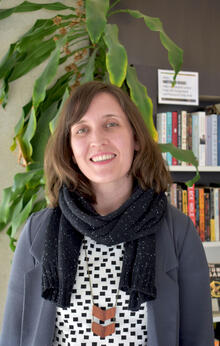
Library archivist uses her skills to advance truth and reconciliation
She hopes her actions inspire and encourage others

She hopes her actions inspire and encourage others
By Pamela Smyth Media RelationsWarning: This story refers to events that some may find upsetting.
When Danielle Robichaud heard about the discovery of the remains of 215 children at the site of the Kamloops Indian Residential School, she got on Wikipedia. It was not for the reason you might think.

> Danielle Robichaud
> Digital Archivist, Special Collections & Archives
She immediately tapped into her skills, digging for historical information and news articles about the school, and any mentions of it in the report of the Truth and Reconciliation Commission of Canada.
“I’ve done a lot of learning and listening to Indigenous peoples, thinkers and writers. A few years ago, I took a class at Renison University College about reconciliation and implications for settler Canadians,” Robichaud said. “The instructor, Kelly Laurila, in addition to being an incredible person, did a really amazing job of imparting the fact that educating ourselves as settler Canadians is only one part of the process. The work really comes with translating what you learned into action. For me, that looks like editing Wikipedia.”
Since the unmarked graves were found in Kamloops, there have been more tragic discoveries at other school locations. Robichaud says many Wikipedia editors have become involved as more remains are found, so she is working on pages for smaller schools that have not had much coverage yet.
A few years ago, Robichaud contributed to revisions to the Wikipedia page for the Canadian Indian residential school system. She worked on it for more than a year, moving it through the review process so it could appear on the Wikipedia main page. In 2018, she received the Archives Association of Ontario’s James J. Talman Award, largely for her work increasing Indigenous representation on Wikipedia.
Robichaud also builds Wikipedia pages about accomplished Indigenous Canadians. She learned that celebrating their achievements is important for reconciliation. So far, she has created pages for Wanda Nanibush, curator of Indigenous art at the Art Gallery of Ontario, filmmaker Marjorie Beaucage and Lori Campbell, educator and former director of the Indigenous Student Centre at Waterloo.
“It’s important to acknowledge that a lot of the work I do stems directly from decades of work that Indigenous thinkers and writers have done before me,” Robichaud said. “I hope that finding ways to put what I’ve learned into action can inspire and encourage other people to think about the skills they already have and how they can be put into action in meaningful ways.”
Danielle Robichaud, a digital archivist at University of Waterloo Library, uses her professional skills to support truth and reconciliation. Listen to her interview in episode 94 of the Beyond the Bulletin podcast to learn more.

Read more
Uncovering the remains of Indigenous children at residential schools in B.C. and Saskatchewan is causing people to reflect on what Canada Day means

Read more
Why NIHM should be important to everyone

Read more
Savanah Seaton wants to help employers create workplaces where Indigenous employees can feel a sense of belonging and fully contribute their untapped knowledge, skills and abilities.
The University of Waterloo acknowledges that much of our work takes place on the traditional territory of the Neutral, Anishinaabeg, and Haudenosaunee peoples. Our main campus is situated on the Haldimand Tract, the land granted to the Six Nations that includes six miles on each side of the Grand River. Our active work toward reconciliation takes place across our campuses through research, learning, teaching, and community building, and is co-ordinated within the Office of Indigenous Relations.